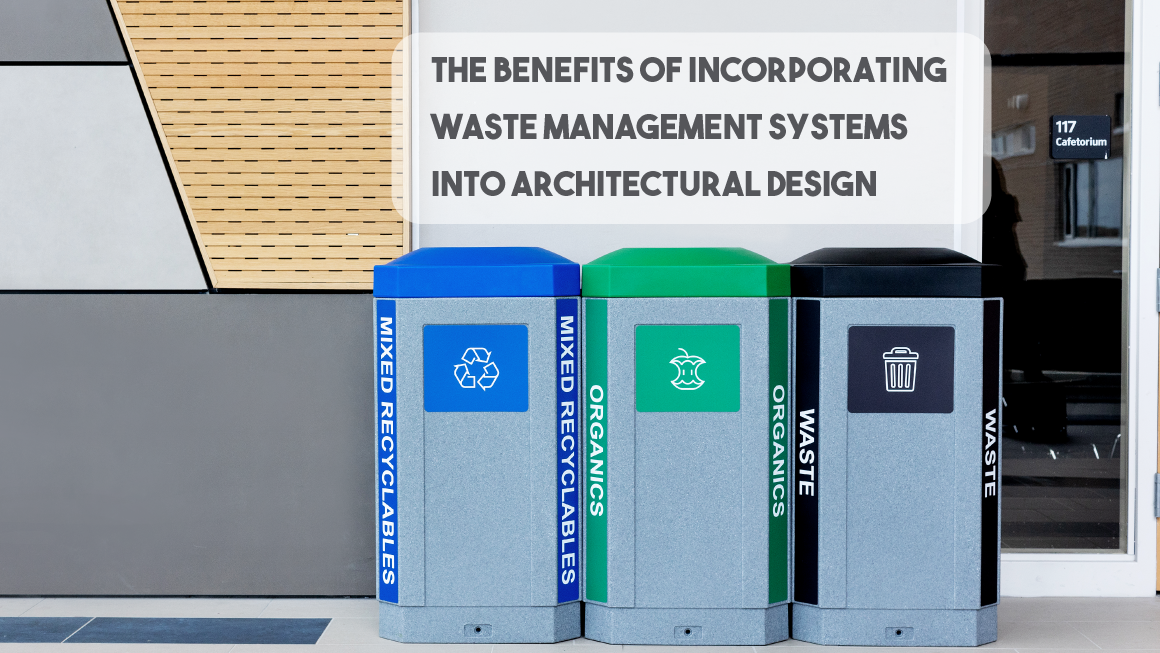The concepts of eco-friendliness and zero waste are rapidly gaining traction within the architectural community. As environmental concerns become increasingly pressing, the expectation to integrate sustainable solutions into architectural designs is at an all-time high. One of the most effective ways to meet this demand is by prioritizing waste management systems in your building designs. Many architects have already taken steps to incorporate advanced recycling and organics collection, creating user-friendly waste management systems that set their projects apart in both functionality and environmental responsibility.
Here’s a closer look at the key benefits of integrating a robust waste management program into your next design:
Economic Impact
Budget considerations are at the forefront of every architectural project. While implementing advanced waste management solutions may seem like an additional expense, the long-term financial advantages make it a smart investment for both architects and building owners. Beyond the obvious environmental and social benefits, here are the economic upsides you can propose to developers and building managers:
Substantially Reduced Waste Disposal Costs
Waste removal fees can quickly escalate, particularly in urban or remote locations. By diverting recyclables such as paper, plastic, and metal from the waste stream, facilities can reduce their waste disposal costs by as much as 50%. While recycling collection does involve an initial cost, these expenses are often recovered through significant savings on general waste removal. Designing buildings with efficient waste management systems is an investment that pays for itself over time.
Supporting a Healthy Economy
According to a study by Waste Wise, recycling is a critical component of both national and state economies, creating jobs and reducing costs for waste generators. Businesses and government entities alike recognize that recycling not only makes environmental sense but also fosters economic growth. The jobs sustained by the recycling industry contribute to a stronger economy, and a thriving economy drives demand for architectural development. By incorporating waste management solutions, you are aligning your designs with broader economic trends and contributing to sustainable growth.
Leveraging Recycled Materials
Recycled materials hold substantial value and can be repurposed within a circular economy. These materials can offer significant cost savings for clients and enhance the sustainability profile of your design. Architects can also integrate recycled content into building materials, further reducing procurement costs while promoting eco-friendly construction practices.
Enhancing Facility Cleanliness and Maintenance Efficiency
A clear and well-communicated waste management system not only reduces litter but also promotes cleanliness throughout the building. This enhances the visual appeal of your design and reduces the need for extensive janitorial services. Guests and staff are more likely to adhere to waste disposal guidelines when recycling and organics options are readily available, which translates into lower maintenance costs for building operators. A clean and sustainable environment is an integral part of modern building design, benefitting both aesthetics and operational efficiency.
Social Impact
Architects are often deeply involved in promoting community welfare through thoughtful design. A comprehensive waste management program can play a significant role in fostering a healthy social environment and demonstrating a commitment to corporate social responsibility.
Demonstrating Environmental Leadership
Architects who prioritize recycling and organics collection in their designs showcase their dedication to environmental stewardship. By integrating sustainable practices into your projects, you signal a clear commitment to a greener future, empowering guests, residents, and employees to adopt eco-friendly habits in their daily lives. This commitment resonates with socially conscious clients and communities, enhancing the reputation of your design firm.
Contributing to Job Creation
Waste management systems, particularly those focused on recycling and processing materials, contribute significantly to job creation. According to the Institute for Local Self-Reliance, industries involved in sorting and processing recyclables employ ten times more workers than traditional waste disposal services. By incorporating these systems into your designs, you are directly supporting local economies and contributing to the transition toward a more sustainable and resilient society.
Encouraging Social Responsibility
When people see that recycling is encouraged and supported in their community, including in the buildings they frequent, they are more likely to adopt responsible waste management behaviors. Your design can foster a sense of social pressure to participate in recycling, helping to create cleaner public spaces and encouraging environmentally conscious habits. As buildings become hubs of sustainability, visitors are more inclined to use waste, recycling, and organics receptacles properly.
Environmental Impact
As the global urgency to address climate change intensifies, architects face increasing pressure to innovate and lead the way in sustainable design. Waste management is a powerful tool for reducing the environmental impact of buildings, and incorporating these systems into your designs can have far-reaching benefits.
Reducing Pollution and Conserving Resources
Recycling plays a vital role in mitigating pollution by diverting waste away from landfills, where harmful chemicals and greenhouse gases are released as materials decompose. By reducing the need for raw materials, recycling helps preserve natural habitats such as rainforests, protecting biodiversity. Additionally, recycling requires far less energy than producing goods from virgin materials, further reducing the environmental footprint of your designs.
Expanding to Organics Collection
While the benefits of recycling are well-known, including organics collection in your designs offers even greater environmental advantages. Organic waste, such as food scraps, is a major source of methane emissions when sent to landfills. Methane is a potent greenhouse gas, significantly more effective than carbon dioxide at trapping heat in the atmosphere. Diverting organics from landfills reduces methane emissions and lowers the risk of leachate, a toxic byproduct that threatens water supplies.
Composting organic waste also returns valuable nutrients to the soil, improving soil health and reducing the need for chemical fertilizers. This promotes biodiversity and supports sustainable agricultural practices, making organics collection a vital component of eco-friendly design.
Setting a New Standard for Architectural Innovation
As an architect, you have the opportunity to lead by example and inspire environmental change on a large scale. By incorporating comprehensive waste management systems into your designs, you set a new standard for the industry, influencing future building projects and encouraging others to adopt sustainable practices. Your designs can inspire thousands of individuals to reconsider their recycling habits, helping to create a ripple effect of positive environmental impact.
By incorporating advanced waste management solutions into your architectural designs, you not only enhance the sustainability of your projects but also position yourself as a leader in the field. The economic, social, and environmental benefits of these systems are clear—and the positive impact of your work will be felt for generations to come. We encourage you to share your experiences and successes in implementing these innovations, as your insights can help drive further advancements in sustainable design.



